
GROUP-4-PLANT-TAXONOMY. (1).docx
GROUP 4
Plant Taxonomy & Field Work
DETAILED REPORT
OF THE LITERATURE OF PLANT TAXONOMY
Alimboyong, Kent Joel A.
Molino, Rea Cris
Napal, Vincent Ian
Pico, Rhean Joy
Quiñonez, Juliah M.
Sebuala, Dane Aldriech
Pre-Test
1. What type of stem modification is exemplified by rhizomes and tubers?
A) Aerial modifications
B) Above ground/sub aerial modifications
C) Underground modifications
D) Aquatic modifications
2. Which of the following is an example of an underground stem modification?
a) Tendril
b) Rhizome
c) Thorn
d) Cladode
3. Which leaf venation pattern is characteristic of monocots?
a) Reticulate
b) Parallel
c) Pinnate
d) Palmate
4. What is the main function of the root cap?
a) Absorption of water and minerals
b) Anchoring the plant
c) Protecting the root tip
d) Storing food
5. Which of the following is a type of dry simple fruit?
a) Berry
b) Drupe
c) Legume
d) Pepo
6. What type of Flora's covers a limited geographical area usually state, city, valley or small mountain range?
A. Local Flora
B. Regional Flora
C. National Flora
D. Continental Flora
7. What work of Linnaeus consistently apply binomial names and is still used today as the starting point for the naming of plants?
A. Species plantarum
B. Genera plantarum
C. Hortus Malabaricus
8. CDFP stand for?
A. Co's digital flora of the Philippines
B. Cos digit flora of the Philippines
C. Co's digital flower of the Philippines
9. What type of Flora covering a country?
A. Local flora
B. Regional flora
C. National flora
D. Continental flora
10. How many cotyledons are present in a monocot seed?
a) 0
b) 1
c) 2
d) 3
11. How many cotyledons are present in a monocot seed?
a) 0
b) 1
c) 2
d) 3
12. What does a monograph typically focus on?
A) Species
B) Genus or family
C) Individual plant
13. What is the function of stipules on a leaf petiole?
A) Photosynthesis
B) Protection from herbivores
C) Support for the leaf blade
D) Attachment of the leaf to the stem
14. What are periodicals?
A) One-time publications
B) Regular publications
C) Annual reports
15. Hortus Malabaricus means?
A. Gardern of Malabar
B. Garden of kerala
C. Garden of Goa
GENERAL LITERATURE AND INDEX IN PLANT TAXONOMY
REPORTER: Rhean Joy Pico
Introduction
Taxonomy has one of the oldest and most voluminous literature because it is oldest among different disciplines of science. A taxonomist must be fully acquainted and should have a thorough knowledge of taxonomic literature, as it is a very essential part of identification of an unknown plant, solution of a nomenclatural problem, or a monographic or revisionary or floristic study. There is no single source dealing exclusively with taxonomic literature; it would occupy several volumes.
General Literature on Taxonomy:
Taxonomic Literature (TL):
It covers full bibliographical details including precise data of publication as well as biological data of the authors. Taxonomic literature is a series of seven volumes and commonly as TL 2, because it is expanded version of an earlier catalog
Classical Literature on Plant Taxonomy
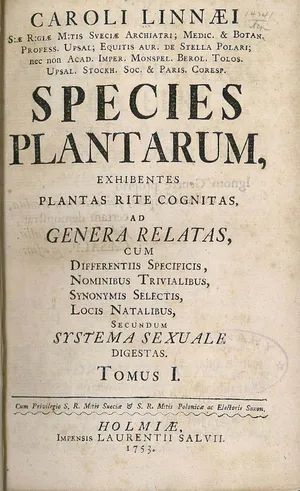
Species Plantarum
It was published by Carolus Linneaus in 2 volumes. First in May 1753 and second in August 1753. Binomial system of nomenclature adopted in it for the first time. It accepted the rule of priority in the nomenclature of flowering plants and pteridophytes. It does not provide generic description.
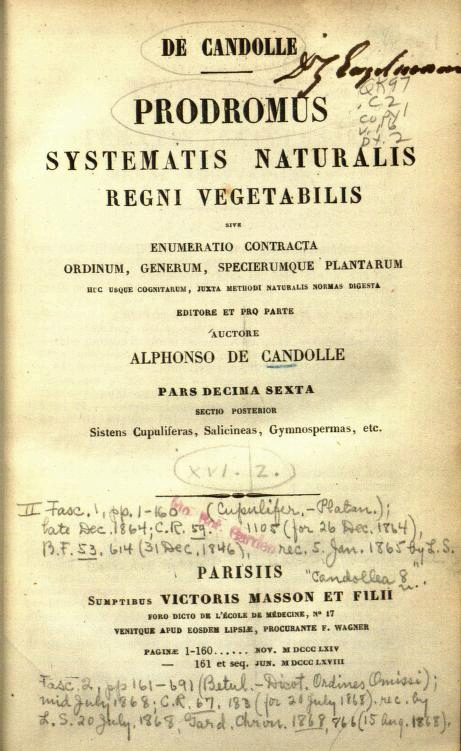
Prodromus Systamatis naturalis regni
vegetabilis:
Published by AP de Candole, in 17 volumes (1824-1873) providing the account for all species of seed plants.

Hortus Indicus Malabaricus (1678-1703):
Published in 12 parts containing the account of 794 plants of Malabar region. It is Prelinnean publication and first authentic record of plants.
Hortus Malabaricus is the oldest important printed book on Indian medicinal plants. The 1(st) of its 12 volumes was published in 1678 from Amsterdam this book, written by H.A. Van Rheede is perhaps the only authentic record of the ethnoiatrical knowledge of ancient Malabar, available to us today.
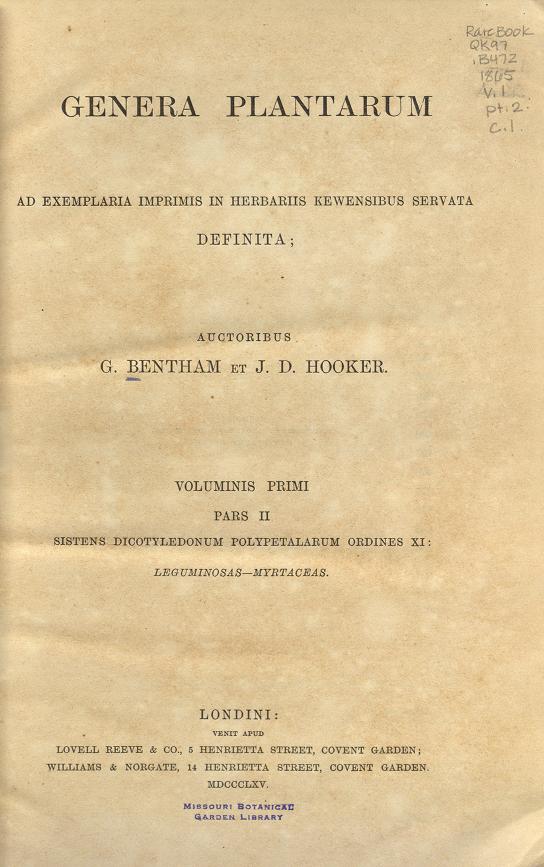
Genera Plantarum:
Bentham and Hooker published their classification of flowering plants in
volumes. Description of all genera are original and in Latin. No key is used in the work.
Genera Plantarum is a highly influential work in the history of plant classification. However, the importance of the work for names at the rank of species is equivocal.
 Die Naturlichen Pflanzen familien:
Die Naturlichen Pflanzen familien:
Published by A. Engler and K. Prantl in 23 volumes. It is written in German Plants are described using dichotomous keys. This work is a complete revision of plant families down to generic level and often even further.
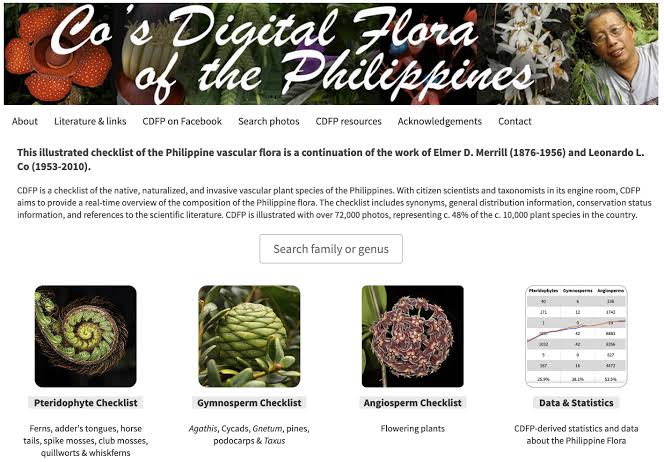
Cos Digital Flora:
Co's Digital Flora of the Philippines (CDFP) is a free and publicly accessible, well-illustrated website that aims to provide up-to-date taxonomic information and a comprehensive overview of Philippine vascular plants.
General Taxonomic Indexes
The indexes serve as an aid to locate quickly the source of original publication of a name.
Important Indexes to Vascular plants are as follows:
Index Kewensis Plantarum Phanerogamarum
This work/book/publication is corner stone to the literature on systematics of flowering plants. 13 The compilation of original work was made possible by gift of money by Charles Darwin. It compiled at the Royal Botanic Garden, Kew by BD Jackson and JD Hooker. Also called Index Kewensis.
Index Kewensis is the reference employed to determine the source of the original publications of a generic name or binomial of a seed plant. The original two volumes of the Index Kewensis listed 400,000 names of plant species published since 1753 to 1895. About 6000 names added every year.
Gray Herbarium Card Index
Published by Harvard University, Cambridge, Massachusetts, USA. It has database account of the flowering plants and pteridophytes of the Western Hemisphere. It has covered 287225 cards for taxa published since 1873.
Genera Siphonogamarum
(Berlin, 1900-1907). The work edited by CG Dalla Torre & H Harms, accounts for the names published for families and genera of spermatophytes in one volume. Orders and families are arranged according to Engler & Prantl’s System of classification.
Index NominumGenericorum [ING], Botany
A compilation of generic names for organisms covered by the ICN:
“International Code of Nomenclature for Algae, Fungi and Plants”. Details of
valid publication, precise date of publication, type specimen, basionym(s), of
each organism is maintained as a card. Every card has name of genus, serial
number, and the designation of person who prepared the card. The first issue
published in 1955.
References
Barcelona, J. et al. (2013). Co's Digita FloraFlora of the Philippines: Plant Identification and Conservation through Cybertaxonomy. Philippine Journal of ScienceScience 142:57-67
Bhan, P. (2016, July 12). Literature on Taxonomy | Systematic Botany. Biology Discussion. Retrieved July 4,2024 https://www.biologydiscussion.com/angiosperm/taxonomy-angiosperm/literature-on-taxonomy-systematic-botany/34716#google_vignette
Singh, A.K. (n.d.). Taxonomic resources and nomenclature (PDF FILE).
https://www.google.com/urlsa=t&source=web&rct=j&opi=89978449&url
BOTANICAL GLOSSARIES AND DICTIONARIES
REPORTER: Dane Aldriech Sebuala
BOTANICAL GLOSSARIES
INTRODUCTION:
The study of plants sometimes requires the use of specialized terms to describe unique plant parts or characteristics, thus a glossary of botanical terms used in the species descriptions.
Botanical glossaries
"It is a list of terms and concept relevant to botany and plant in general."
Almost all modern book, manual, floras etc. include glossary of botanical terms. Glossaries can be published as separate work of definitive terms and concepts.
IMPORTANCE OF BOTANICAL GLOSSARIES
Botanical glossaries provide standardized definitions for plant-related terms, ensuring consistency and clarity in communication among botanists, horticulturists, and plant enthusiasts.
INTRODUCTION:
-Botanical dictionaries contain terms specific to the field of botany. Here are some common botanical terms that you might find in such a dictionary:
It is alphabetic listing of terms or subject matter with the explanation of matter
"A botanical dictionaries may include listing and description of all plants."
Ex-a] dictionary of flowering plants and ferns-J.C willis [1973]
B) dictionary of economic product of India G.watt [1889-1896]
Achenes: A type of simple, dry fruit that does not open at maturity.
Angiosperm: A plant that has flowers and produces seeds enclosed within a carpel.
Axil: The angle between the upper side of a leaf or stem and the supporting stem or branch.
Bract: A modified leaf or scale, typically small, with a flower or flower cluster in its axil.
Calyx: The sepals of a flower, typically forming a whorl that encloses the petals and forms a protective layer around a flower in bud.
Carpel: The female reproductive organ of a flower, consisting of an ovary, a stigma, and usually a style.
Chlorophyll: The green pigment found in plants and algae, essential for photosynthesis.
FLORAS AND MANUALS
FLORAS
A flora is a systematic enumeration of the plant species occurring in a given region. A flora may cover any suitable area from a Taluka to district, state, country or even a continent. The word "flora" also refers to publication made from systematic enumeration of the plant species.
Flora is a book containing information about plants in systematic arrangement found in a particular region."
EXAMPLE OF FLORAS
Examples of flora include: trees, such as chestnut; shrubs, such as roses; and grasses
Floras are classified on the basic of their geographical areas
A] local flora covers a limited geographical area usually state, city, valley or small mountain range
Ex-flora of delhi-by JK Maheshwari [1963]
B] Regional flora-covers a large geographical areas, usually a country or botanical garden.
Ex-flora of British India by JB hooker [1872-1897] [7 vol.)
C) National flora-Flora covering a country
Ex-flora of India
D] Continental flora - covers the entire continent
Ex-flora of eupnea - by T.G tutin [1964-1980][5 vol.]
MANUALS
A manual applies much more broadly to plants, and typically instructs you on a subject (e.g., identification/differentiation of species). A manual does not need to be exhaustive and its scope is typically user defined (though often based on the scale/range of its underlying subject). However, some have used the term manual to be more or less synonymous with Flora or otherwise similar document (e.g., see here).
Manual
"Manual is a book containing complete listing and description of the plants growing in a particular area but generally it covers the specialized group of plants."
It provides complete description of plants Arranged in alphabetic
wise
Helps to identify name of a particular species found in that geographic area.
Contain more descriptive then flora.
Contain identification, description and glossary.
Ex-al manual of poisonous c) manual of aquatic plants
plants,
b) manual of cultivated plants, d) manual of flowering plants
REFERENCE
Glossary of Botanical Terms. (n.d.-b). https://ecologicalatlas.uaf.edu/index.php/about-atlas/understanding-data/glossary/
Plant Information Center - Botanical Dictionary. (n.d.). https://www.ibiblio.org/pic/botanical_dictionary.htm
Flora. (n.d.). https://bsi.gov.in/page/en/flora#:~:text=A%20flora%20is%20a%20systematic,enumeration%20of%20the%20plant%20species
What is the difference between taxonomical aids Flora and Manual? (n.d.). Biology Stack Exchange. https://biology.stackexchange.com/questions/38714/what-is-the-difference-between-taxonomical-aids-flora-manual-and-catalogue
MONOGRAPHS AND REVISION
REPORTER: Juliah Quiñonez
Monographs and revisions are comprehensive works focusing on a single plant group (e.g., a genus or family). They include detailed descriptions, classifications, and often include keys to species, distribution maps, and illustrations.
Some examples of monographs in plant taxonomy:
Journals
Taxonomic information can be published in journals, which used to be primarily offline but are now often available online. Both offline and online journals help disseminate taxonomic data to a wide audience, making it easy to reproduce and retrieve this information. These journals are accessible in both physical (hard copy) and digital (soft copy) formats, allowing users to refer to them anytime as e-documents or e-resources.
Examples of journals:
Periodicals
A periodical is a publication that appears at regular intervals, like biweekly, monthly, or quarterly. Each release is called an issue or fascicle, and a collection of these issues forms a volume, often covering a calendar year. Scientific periodicals are usually sponsored by scientific organizations, universities, or museums. These periodicals, also known as serials, may publish at regular or irregular intervals. A society might issue a monthly journal for shorter papers and records of proceedings, titled Journal, Bulletin, or Proceedings, and less frequent publications for longer works, titled Memoirs or Transactions. Titles of periodicals are often abbreviated when cited, but there's no standard way to do this.
Reference:
Das, S. (2020, April 9). Documentation in plant taxonomy [Slides]. SlideShare. https://www.slideshare.net/slideshow/documentation-in-plant-taxonomy/231693522
Biology Discussion. (n.d.). Taxonomic literature of plants: An overview. Retrieved July 3, 2024, from https://www.biologydiscussion.com/plant-taxonomy/taxonomic-literature/taxonomic-literature-of-plants-an-overview/47659
BIBLIOGRAPHY, ABSTRACT AND GUIDE
REPORTER: Molino, Rea Cris
BIBLIOGRAPHY
“Bibliography is a detail list of names of publication of books, journals and scientific literature on a specific topics during a specific period.”
Bibliography refers to a comprehensive list of references cited in a scientific publication, research study, or taxonomic work. This list includes various sources such as scientific papers, books, articles, and other literature that have been consulted, cited, or used in the research process.
It gives the knowledge of date of publication, place and journals name.
EXAMPLE, A. an annotated and bibliography of taxonomic botany of peninsular India – Karthikeyan, Nayan and Raghavan [1959- 1978]
EXAMPLE, B. bibliography of flora and ethnobotany of west Bengal [2010].
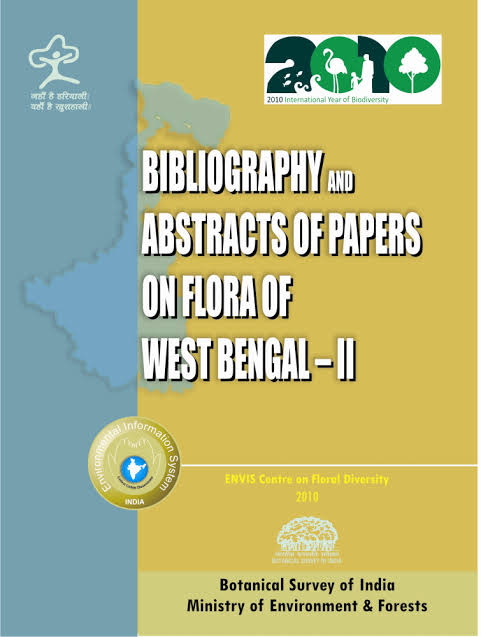
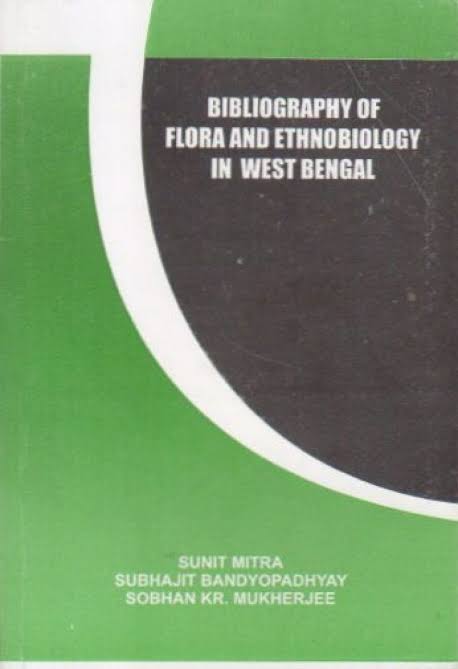
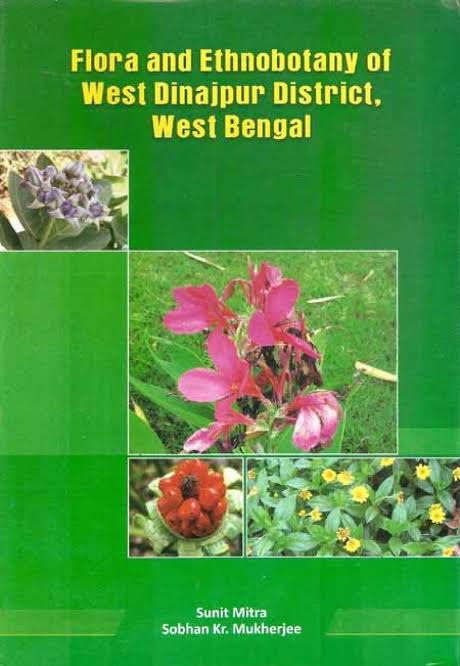
ABSTRACT
“Abstract provide a summary of various articles published in various journals throughout the world.“
ABSTRACT refers to a concise summary or overview of a taxonomic publication, research study, or scientific paper. Abstract may summarize the taxonomic characteristics, classification, relationships, distribution, and other relevant information about a particular group of organisms or species. It highlights the main findings or contributions of the taxonomic study, making it easier for researchers, scientists, and other readers to grasp the significance of the work and its implications for the field of taxonomy.
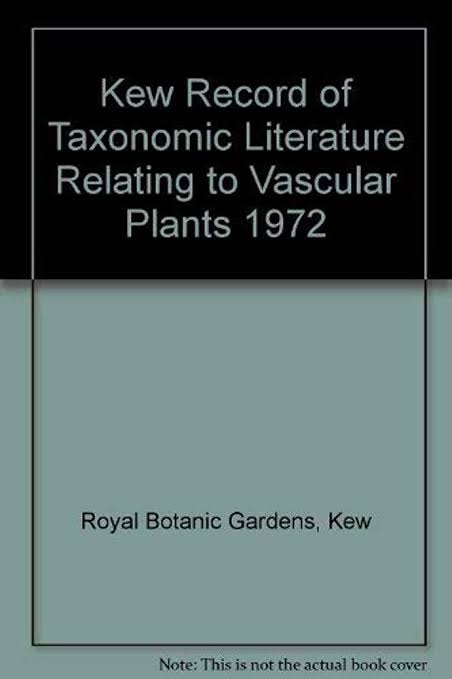 EXAMPLE:
EXAMPLE:
Kew record of taxonomic literature
GUIDES
“Guides are useful to help taxonomist to locate a relevant literature concerning a taxonomic group or a geographical region.”
GUIDE serves as a comprehensive resource that assists researchers, scientists, and enthusiasts in identifying, classifying, and understanding various organisms based on their taxonomic characteristics. Taxonomic guides provide detailed information about the classification, characteristics, relationships, and distribution of different species, helping users navigate the complex world of biodiversity. These guides may include keys, illustrations, descriptions, and other tools to aid in the accurate identification of organisms.
EXAMPLE:
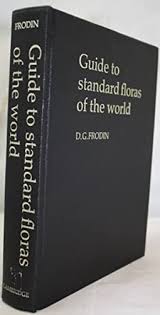 guide to standard floras
guide to standard floras of the world – D.G frodin [1984]
REFERENCES:
https://www.slideshare.net/slideshow/taxonomic-literature-by-alisha-dewangan-pdf/269437172
Chapman, A. D. (2009). Principles of Data Quality. Report for the Global Biodiversity Information Facility, Version 1.0. Copenhagen: Global Biodiversity Information Facility.
Brummitt, R. K., & Powell, C. E. (Eds.). (1992). Authors of plant names: a list of authors of scientific names of plants, with recommended standard forms of their names, including abbreviations. Royal Botanic Gardens, Kew.
Polaszek, A. (2015). The importance of descriptive taxonomy and biological information in biodiversity research. In Foottit, R. G. & Adler, P. H. (Eds.), Insect biodiversity: Science and society (pp. 27-42). John Wiley & Sons.
Wheeler, Q. D., & Meier, R. (2000). Species concepts and phylogenetic theory: a debate. Columbia University Press.
Stuessy, T. F. (2009). Plant Taxonomy: The Systematic Evaluation of Comparative Data. Columbia University Press.
Dallwitz, M. J. (1980). A general system for coding taxonomic descriptions. Taxon, 29(1), 41-46. DOI: 10.2307/1219592
Schmidt, D., & Bell, G. H. (2003). Guide to Reference and Information Sources in the Zoological Sciences.
PLANT MORPHOLOGY: STEM
REPORTER: Kent Joel A. Alimboyong
LEARNING OBJECTIVES:
INTRODUCTION
A morphological description usually starts with the structure of a plant. Plant stems with vascular tissue support leaves and reproductive structures such as flowers. Depending on the type of plant, stems may be woody or herbaceous, and solid or hollow in cross section. Beyond their basic form, stems also undergo notable modifications such as underground stems, above ground/sub aerial, and aerial.
Herbaceous (non-woody) stems do not have a woody stem above the ground, instead they have a soft, green flexible stem.
EXAMPLES:
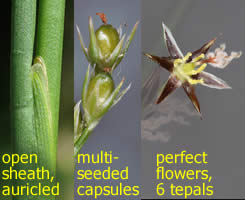
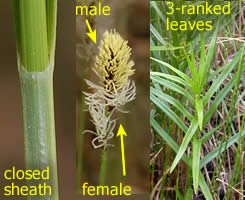
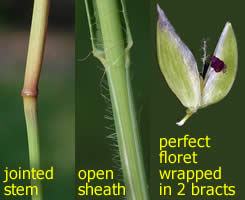 Grasses: the Poaceae family Rushes: the Juncaceae family Sedges: the Cyperaceae family
Grasses: the Poaceae family Rushes: the Juncaceae family Sedges: the Cyperaceae family
Woody stems are permanent structures that grow in length and girth (diameter) each year and produce bark as a protective covering.
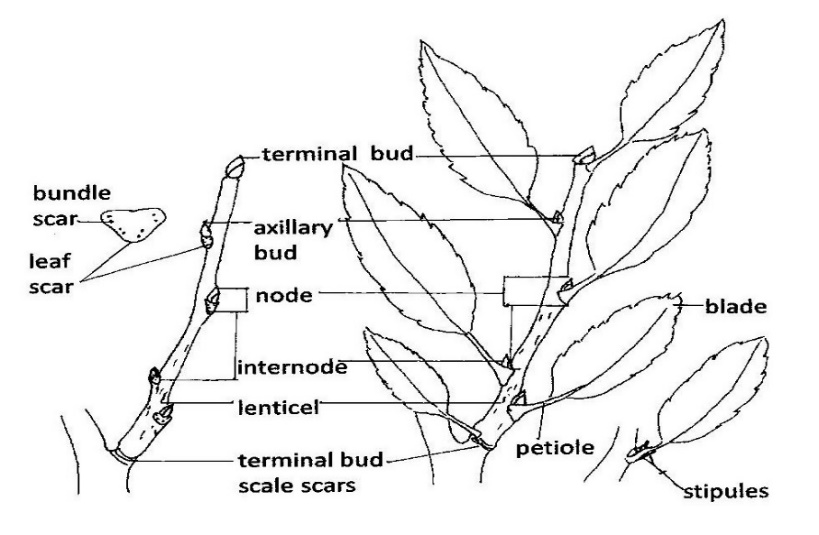
Stem modifications include underground, above ground/sub aerial, and aerial structures that are characteristic to different plant species.
Underground structures for spreading and food storage include
Above ground/Sub aerial stems includes:
Aerial modifications includes:
PLANT MORPHOLOGY: LEAVES
LEARNING OBJECTIVES
Leaf morphology encompasses a rich diversity of features crucial for plant function and classification. They vary greatly in complexity, with simple leaves having a single blade and compound leaves. The arrangement of leaves or buds along a stem ranging from alternate and opposite to whorled patterns. Venation patterns within leaf blades and their varied shapes and its distinctions in leaf apices, bases, and margins.
Leaves arise at nodes just below an axillary bud on woody stems and are usually petiolate that is composed of a blade and stalk-like petiole. Petioles may have stipules, two small leaf-like flaps that are attached at the base.
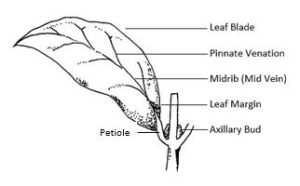
Parts of a simple leaf
However, when a bud is located in the axil of a structure with more than one leaf (leaflet) on attached to the axis (rachis), the leaf is classified as compound. Even or odd numbers of leaflets may be pinnately compound that is, arranged along a central axis (feather-like), or palmately compound from one point on the tip of the petiole, (like fingers on an out-stretched hand). Compound leaves may undergo double or triple compounding into finer segments or leaflets.
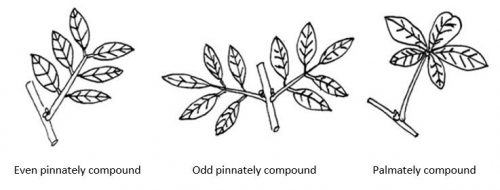
Phyllotaxy, the arrangement of a leaf or bud in relation to another leaf or bud along a plant stem is a useful basis for classifying plants.
Phyllotaxies
Leaf venation refers to the patterns of veins within the leaf blade.
Leaf Shapes
Apices
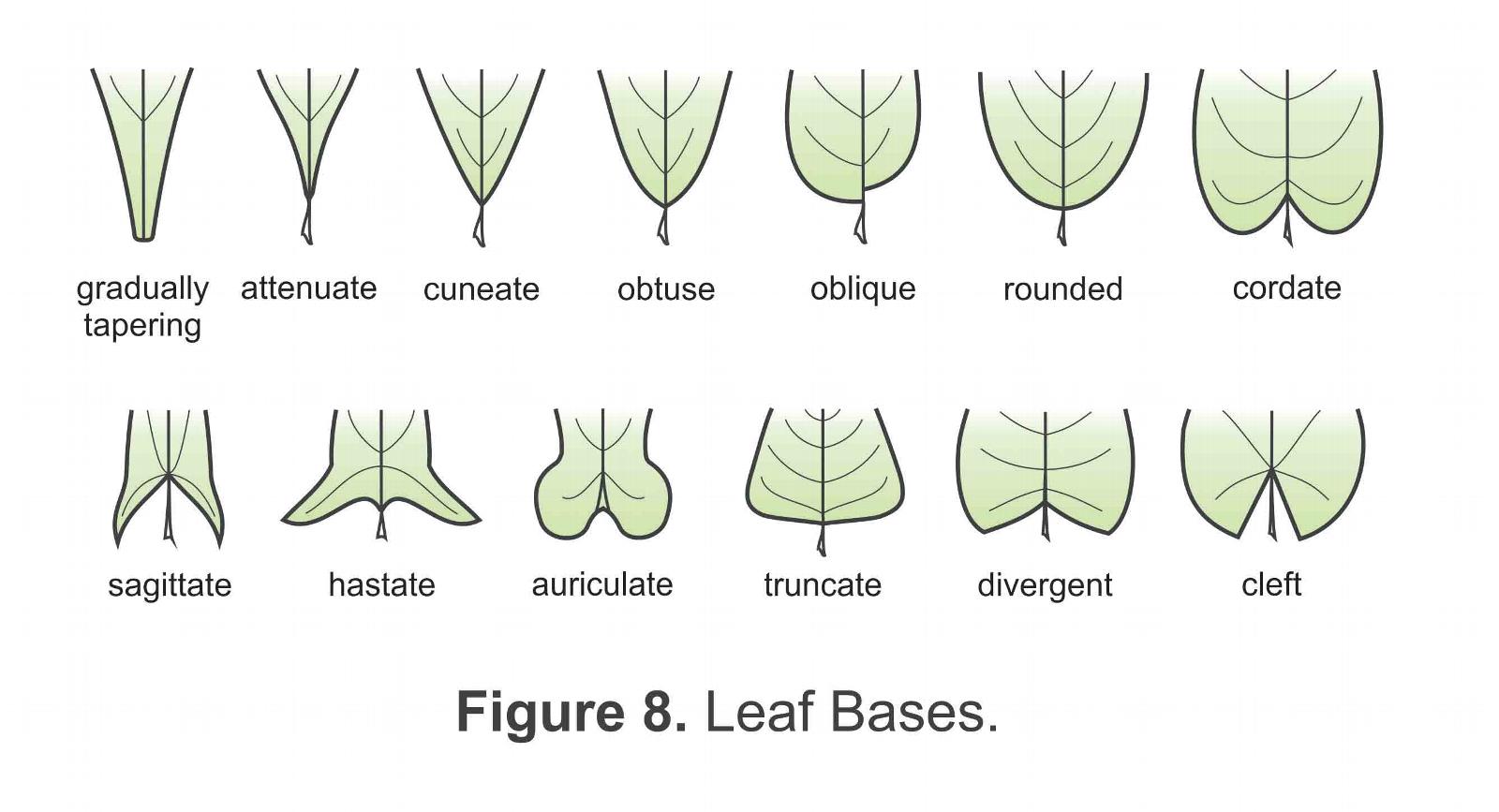 LEAF BASES
LEAF BASES
Margins - The edge or margin is the outside perimeter of a leaf.
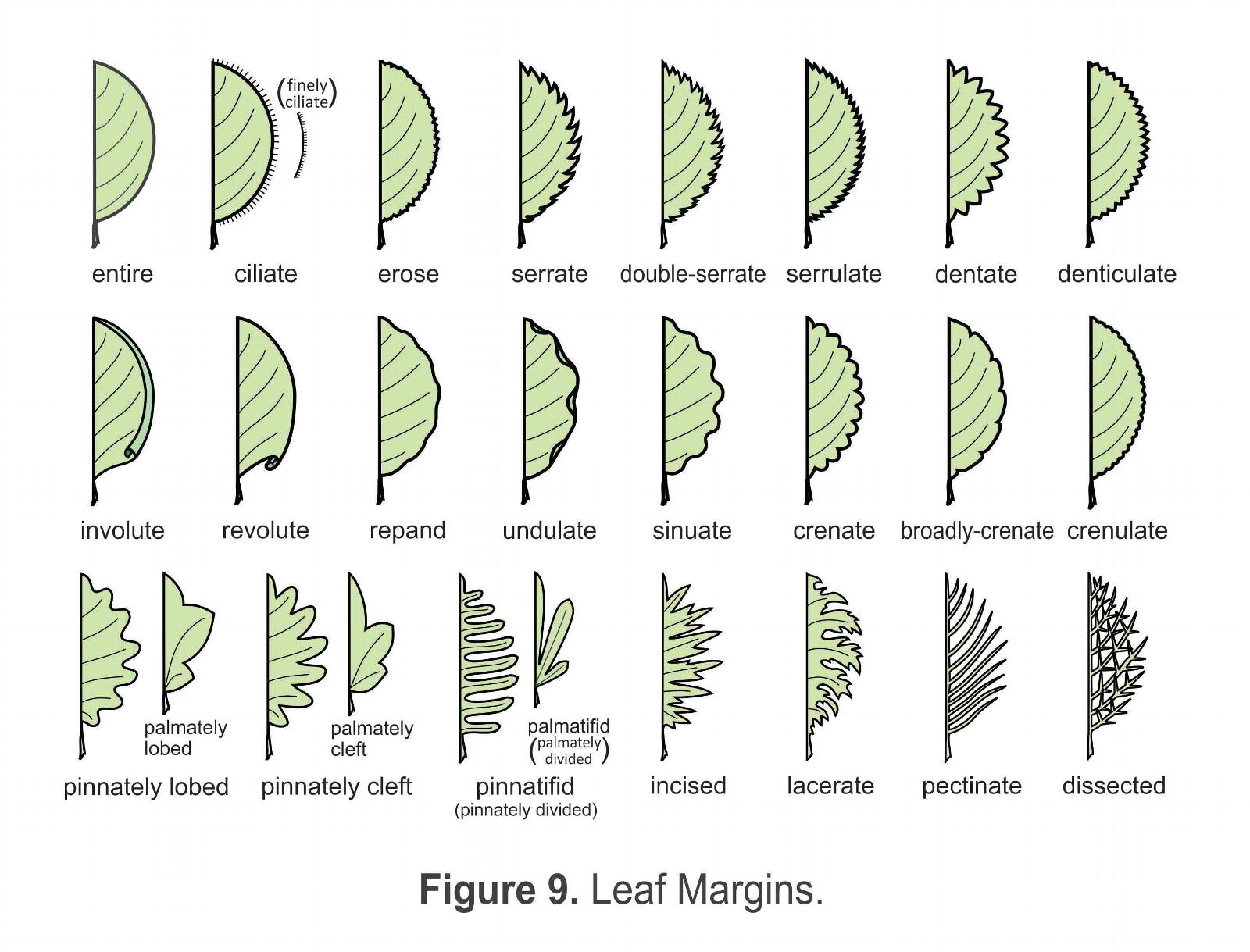
PLANT MORPHOLOGY: SEEDS
LEARNING OBJECTIVES
A seed is a basic part of any plant. The ovules after fertilization, develop into seeds. A seed is made up of a seed coat and an embryo. The embryo is made up of a radicle, an embryonal axis and one (wheat, maize) or two cotyledons (gram and pea). A seed is found inside a fruit which converts into a new plant when we plant it. Hence, the seed is the most important part.
Types of Seeds
A Seed is primarily of two types. The two types are:
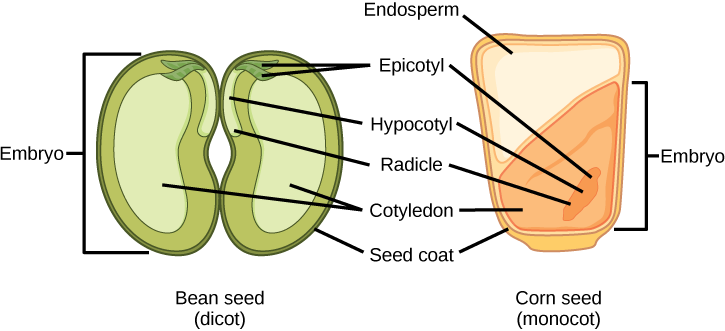 Structure of Seeds
Structure of Seeds
DIFFERENCE BETWEEN MONOCOT AND DICOT SEEDS
CHARACTERISTICS | MONOCOTS SEED | DICOT SEEDS |
Number of cotyledons | Have single cotyledon | Have two distinct cotyledons. |
Cotyledons | Thin and small. | Are fleshy and store food materials. |
Endosperm | Is present which stores a large amount of food for the embryo. | Is reduced or even absent. |
Plumule | Occurs terminally | Occurs laterally |
Shape and size | The shape and size of the monocot are variable, but these are usually less symmetrical and smaller in size. | The shape and size of the dicot are variable, but these are usually more symmetrical and larger in size. |
Reference
Grasses, Sedges and Rushes: Minnesota wildflowers. (n.d.). https://www.minnesotawildflowers.info/page/grasses-sedges-rushes
Wikipedia contributors. (2024, June 21). Leaf. Wikipedia. https://en.wikipedia.org/wiki/Leaf#Surface
Contributors to Wikimedia projects. (2018, November 26). Leaf morphology. Wikimedia Commons. https://commons.wikimedia.org/wiki/Leaf_morphology#shape
Nakano, M. (2020a, September 15). Introduction to plant morphology. Pressbooks. https://opentextbc.ca/plantidentification/chapter/introduction-to-plant-morphology/
The Seed: Definition, types, seeds, structure, videos, solved examples. (2020, May 12). Toppr-guides. https://www.toppr.com/guides/biology/morphology-of-flowering-plants/the-seed/
GLOSSARY - flora of Newfoundland and Labrador. (n.d.). https://newfoundland-labradorflora.ca/glossary/
PLANT MORPHOLOGY: ROOTS
REPORTER: Vincent Ian Napal
Objectives:
Introduction
The roots of seed plants have three major functions: anchoring the plant to the soil, absorbing water and minerals and transporting them upwards, and storing the products of photosynthesis. Some roots are modified to absorb moisture and exchange gases. Most roots are underground. Some plants, however, also have adventitious roots, which emerge above the ground from the shoot.
Structure of Roots
Root Cap - The tip of the root is protected by the root cap, a structure exclusive to roots and unlike any other plant structure. The root cap is continuously replaced because it gets damaged easily as the root pushes through soil, which serves as a protection for meristematic cells at the tip of the root.
Apical Meristem – A region of actively dividing cells located behind the root cap, responsible for root growth and elongation.
Root Hairs – Thin, hair-like extensions of root epidermal cells. It helps increase the surface area for water and nutrient absorption.
Vascular Cylinder – The central part of root containing xylem and phloem, which conducts water, nutrients, and food throughout the plant.
Cortex – The layer between the epidermis and vascular cylinder, where foods are stored, and this layer facilitates the movement of water as well.
Types of Root Systems
Root systems are mainly of two types: Tap Roots and Fibrous Roots. Dicots have a tap root system, while monocots have a fibrous root system.
A tap root system has a main root that grows down vertically, and from which many smaller lateral roots arise. Dandelions are a good example; their tap roots usually break off when trying to pull these weeds, and they can regrow another shoot from the remaining root. A tap root system penetrates deep into the soil.
A fibrous root system is located closer to the soil surface, and forms a dense network of roots that also helps prevent soil erosion (lawn grasses are a good example, as are wheat, rice, and corn).
Some plants have a combination of tap roots and fibrous roots. Plants that grow in dry areas often have deep root systems, whereas plants growing in areas with abundant water are likely to have shallower root systems.
Tap Root | Fibrous Root |
1. It arises from the radicle of the embryo. | 1. It is formed either from places other than radicle or its branches i.e., stem, leaves. |
2. Primary root is persistent. | 2. Primary root is short-lived. |
3. It is always underground. | 3. Adventitious root system can be both underground and above ground. |
4. There is a single main root. | 4. A number of larger roots arise in a cluster. |
5. It can be deep feeder or surface feeder. | 5. If underground, the adventitious root system is usually surface feeder. |
6. Main root is very thick as compared to other root | 6. All roots are generally fibrous. |
7. Distinction of primary, secondary, tertiary and rootlets is quite conspicuous. | 7. There is no such distinction. |
KEY DISTINCTIONS
Root Modification
Root structures may be modified for specific purposes. For example, some roots are bulbous and store starch. Aerial roots and prop roots are two forms of aboveground roots that provide additional support to anchor the plant. Tap roots, such as carrots, turnips, and beets, are examples of roots that are modified for food storage. Epiphytic roots enable a plant to grow on another plant. For example, the epiphytic roots of orchids develop a spongy tissue to absorb moisture. The banyan tree (Ficus sp.) begins as an epiphyte, germinating in the branches of a host tree; aerial roots develop from the branches and eventually reach the ground, providing additional support. In screwpine (Pandanus sp.), a palm-like tree that grows in sandy tropical soils, aboveground prop roots develop from the nodes to provide additional support.
MODIFIED ROOTS
Aerial Roots: Roots that grow above the ground that provides support, absorbs moisture in the air, and facilitates gas exchange.
Prop Roots: Adventitious roots that grow from the stem above the soil and then into the ground, and they provide additional support to the plant as well.
Pneumatophores: Specialized aerial roots that grow upward out of the waterlogged soil. This root facilitates gas exchange in anaerobic soil conditions.
Storage Roots: Roots that are modified to store nutrients, where carbohydrates and other nutrients are stored for future use by plants.
PLANT MORPHOLOGY: FRUITS
Objectives:
Fruit morphology involves understanding the structure, classification, and development of fruits. Botanically, a fruit is defined as the ripened ovary of a flower, together with the seeds within that ovary. This definition often differs from the culinary perspective, where fruits are typically sweet and edible, while vegetables are savory. Below, we delve into the detailed morphology of fruits, their types, and their botanical significance.
Basic Fruit Structure
Stigma: The tip of the carpel where pollen grains adhere.
Style: The channel through which the pollen tube grows.
Ovary: The base of the carpel housing the ovules, which contain the plant's eggs.
The ovary wall, after fertilization, ripens to form the fruit. The ovules develop into seeds, and the ovary matures into the fruit.
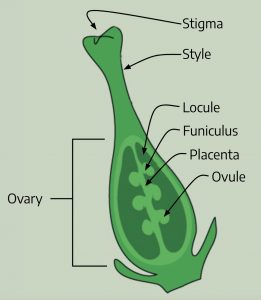
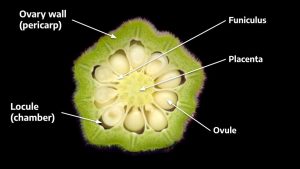
Types of Fruits
Fruits are categorized based on the number of carpels and flowers involved in their formation, as well as the texture and function of their pericarps (fruit walls).
Simple Fruits: Formed from one carpel or multiple fused carpels within a single flower.
Fleshy Simple Fruits:
Dry Simple Fruits:
Aggregate Fruits: Formed from multiple carpels within one flower. Each carpel's ripened ovary coalesces into a single larger unit (e.g., raspberry, which is a collection of small drupelets).
Multiple Fruits: Formed from the ovaries of multiple flowers, which merge into a single large fruit (e.g., pineapple).
Accessory Fruits
Accessory fruits include tissues other than the ovary wall in their structure. They can arise from flowers with epigynous or perigynous parts, where tissues surrounding the ovary adhere to it during fruit development.
Pome: The fleshy part eaten is derived from the hypanthium tissue, not the ovary wall (e.g., apple, pear).
Strawberry: The red fleshy part is the swollen receptacle of the flower, and the actual fruits are the tiny achenes on the surface.
Fruit Morphology and Plant Propagation
Fruits play a crucial role in plant propagation by protecting seeds and aiding in their dispersal. The structure of fruits determines how they interact with their environment and how seeds are distributed. For example:
Dehiscent Fruits: Open to release seeds, aiding in dispersal (e.g., legume).
Indehiscent Fruits: Retain seeds within the pericarp, which might be spread by animals or other mechanisms (e.g., nut).
PLANT MORPHOLOGY: FLOWERS
Learning Objectives:
Introduction
Plant morphology, specifically the study of flowers, plays a crucial role in plant identification and understanding evolutionary relationships. Reproductive structures, such as the number and arrangement of flower parts and the structure of cones, are more significant in evolutionary terms than vegetative structures like leaves and stems, which are more plastic and changeable. Despite the seasonal availability of flowers and fruit, digital resources and herbarium samples enable the identification and study of these patterns.
Flower Shape and Structure
Flower shape, color, and markings are essential for plant identification. Common flower shapes used for identification include:
Rotate: Wheel-shaped
Campanulate: Bell-shaped
Funnelform: Funnel-shaped
Urceolate: Urn-shaped
Salverform: Trumpet-shaped with a long tube
Ligulate: Strap-shaped
Bilabiate: Two-lipped
Papilionaceous: Butterfly-shaped

Flower Parts
A typical angiosperm flower, borne on a peduncle (stalk), comprises the following parts:
Receptacle: The base of the flower
Sepals (Calyx): Protective leaf-like structures
Petals (Corolla): Often colorful and attract pollinators
Stamens: Male reproductive part (includes anther and filament)
Pistil (Carpel): Female reproductive part (includes stigma, style, and ovary)
Flower parts may be fused or separate and usually exhibit one of two types of symmetry:
Radial Symmetry: Star-shaped, symmetrical around a central axis
Bilateral Symmetry: Two mirror-image halves
Flower Completeness and Perfection
Flowers are classified based on the presence of their parts:
Complete Flowers: Have all four main flower parts (sepals, petals, stamens, and pistils).
Incomplete Flowers: Missing one or more main flower parts.
Perfect Flowers: Contain both male (stamens) and female (pistils) reproductive parts.
Imperfect Flowers: Contain only male or female reproductive parts.
Plant species may exhibit:
Dioecy: Individual plants produce either male or female flowers or cones on separate plants.
Monoecy: Individual plants produce both male and female flowers and cones on the same plant.
Inflorescence Types
Flowers in angiosperms are arranged on a structure called an inflorescence, which can support a solitary flower or a group of flowers (florets). Inflorescences facilitate pollination by displaying flowers to pollinators or exposing flower parts to pollen carried by air currents.
Spike: Unbranched, flowers directly attached to the stem
Raceme: Unbranched, flowers attached by short pedicels
Corymb: Flowers with pedicels of varying lengths to form a flat-topped cluster
Panicle: Branched, with each branch bearing multiple flowers
Umbel: Pedicels arise from a common point, forming a flat or rounded cluster
Cyme: Flowers arise in a determinate pattern, with the oldest flower at the top
Dichasial Cyme: Branches in pairs, each bearing a flower
Helicoid Cyme: Flowers arise on one side, forming a spiral pattern
REFERENCES
3.2: Roots. (2020, February 29). Biology LibreTexts. https://bio.libretexts.org/Bookshelves/Botany/Botany_(Ha_Morrow_and_Algiers)/03%3A_Plant_Structure/3.02%3A_Roots#:~:text=Roots%20are%20plant%20organs%20that
7.2: Flower Morphology. (2022, July 26). Biology LibreTexts. https://bio.libretexts.org/Bookshelves/Botany/The_Science_of_Plants_-_Understanding_Plants_and_How_They_Grow_(Michaels_et_al.)/07%3A_Meristems_and_Flowers/7.02%3A_Flower_Morphology
Michaels, T., Clark, M., Hoover, E., Irish, L., Smith, A., & Tepe, E. (2022). 8.1 Fruit Morphology. Open.lib.umn.edu. https://open.lib.umn.edu/horticulture/chapter/8-1-fruit-morphology/
Morphology of fruits. (2021, January 2). SlideShare. https://www.slideshare.net/slideshow/morphology-of-fruits-240843833/240843833#8
Nakano, M. (2020). Plant Morphology – Flowers and Fruit. Opentextbc.ca. https://opentextbc.ca/plantidentification/chapter/plant-morphology-flowers-and-fruit/
Roots | Biology for Majors II. (n.d.). Courses.lumenlearning.com. https://courses.lumenlearning.com/wm-biology2/chapter/roots/
Shahare, P. (n.d.). Topic: Root Morphology. https://www.dbscience.org/wp-content/uploads/2020/03/SEM-II_UNIT-II_Root-Morphology_Dr.Prashant-_Shahare.pdf
Post-Test
1. Which type of seed has two cotyledons and stores food materials in them?
A) Dicotyledonous seed
B) Monocotyledonous seed
C) Endospermic seed
D) Epigeal seed
2. Which of the following is a characteristic feature of woody stems?
A) They have hollow cross sections filled with pith.
B) They produce bark as a protective covering.
C) They are typically herbaceous and lack vascular tissue.
D) They do not undergo annual growth in girth.
3. What kind of index that contain a card that has a name of genus, serial number, and the designation of person who prepared the card?
A. Index NominumGenericorum [ING
B. Gray Herbarium Card Index
C. Index Kewensis Plantarum Phanerogamarum
4. What is the main function of the root cap?
a) Absorption of water and minerals
b) Anchoring the plant
c) Protecting the root tip
d) Storing food
5. Who are the author of genera plantarum that was published in three volumes between 1862 and 1883?
A. Bentha and Hooker
B. Linnaeus
C. Engler
6. What work of Linnaeus consistently apply binomial names and is still used today as the starting point for the naming of plants?
A. Species plantarum
B. Genera plantarum
C. Hortus Malabaricus
7. CDFP stand for?
A. Co's digital flora of the Philippines
B. Cos digit flora of the Philippines
C. Co's digital flower of the Philippines
8. What are periodicals?
A) One-time publications
B) Regular publications
C) Annual reports
9. Hortus Malabaricus means?
A. Gardern of Malabar
B. Garden of kerala
C. Garden of Goa
10. What does a monograph typically focus on?
A) Species
B) Genus or family
C) Individual plant
11. Which of the following is a type of dry simple fruit?
a) Berry
b) Drupe
c) Legume
d) Pepo
12. Which leaf venation pattern is characteristic of monocots?
a) Reticulate
b) Parallel
c) Pinnate
d) Palmate
13. What type of Flora's covers a limited geographical area usually state, city, valley or small mountain range?
A. Local Flora
B. Regional Flora
C. National Flora
D. Continental Flora
14. What type of Flora covering a country?
A. Local flora
B. Regional flora
C. National flora
D. Continental flora
15. What do taxonomic revisions often rely on?
A) Field studies
B) Laboratory experiments
C) Herbarium studies
GROUP 4
Plant Taxonomy & Field Work
DETAILED REPORT
OF THE LITERATURE OF PLANT TAXONOMY
Alimboyong, Kent Joel A.
Molino, Rea Cris
Napal, Vincent Ian
Pico, Rhean Joy
Quiñonez, Juliah M.
Sebuala, Dane Aldriech
Pre-Test
1. What type of stem modification is exemplified by rhizomes and tubers?
A) Aerial modifications
B) Above ground/sub aerial modifications
C) Underground modifications
D) Aquatic modifications
2. Which of the following is an example of an underground stem modification?
a) Tendril
b) Rhizome
c) Thorn
d) Cladode
3. Which leaf venation pattern is characteristic of monocots?
a) Reticulate
b) Parallel
c) Pinnate
d) Palmate
4. What is the main function of the root cap?
a) Absorption of water and minerals
b) Anchoring the plant
c) Protecting the root tip
d) Storing food
5. Which of the following is a type of dry simple fruit?
a) Berry
b) Drupe
c) Legume
d) Pepo
6. What type of Flora's covers a limited geographical area usually state, city, valley or small mountain range?
A. Local Flora
B. Regional Flora
C. National Flora
D. Continental Flora
7. What work of Linnaeus consistently apply binomial names and is still used today as the starting point for the naming of plants?
A. Species plantarum
B. Genera plantarum
C. Hortus Malabaricus
8. CDFP stand for?
A. Co's digital flora of the Philippines
B. Cos digit flora of the Philippines
C. Co's digital flower of the Philippines
9. What type of Flora covering a country?
A. Local flora
B. Regional flora
C. National flora
D. Continental flora
10. How many cotyledons are present in a monocot seed?
a) 0
b) 1
c) 2
d) 3
11. How many cotyledons are present in a monocot seed?
a) 0
b) 1
c) 2
d) 3
12. What does a monograph typically focus on?
A) Species
B) Genus or family
C) Individual plant
13. What is the function of stipules on a leaf petiole?
A) Photosynthesis
B) Protection from herbivores
C) Support for the leaf blade
D) Attachment of the leaf to the stem
14. What are periodicals?
A) One-time publications
B) Regular publications
C) Annual reports
15. Hortus Malabaricus means?
A. Gardern of Malabar
B. Garden of kerala
C. Garden of Goa
GENERAL LITERATURE AND INDEX IN PLANT TAXONOMY
REPORTER: Rhean Joy Pico
Introduction
Taxonomy has one of the oldest and most voluminous literature because it is oldest among different disciplines of science. A taxonomist must be fully acquainted and should have a thorough knowledge of taxonomic literature, as it is a very essential part of identification of an unknown plant, solution of a nomenclatural problem, or a monographic or revisionary or floristic study. There is no single source dealing exclusively with taxonomic literature; it would occupy several volumes.
General Literature on Taxonomy:
Taxonomic Literature (TL):
It covers full bibliographical details including precise data of publication as well as biological data of the authors. Taxonomic literature is a series of seven volumes and commonly as TL 2, because it is expanded version of an earlier catalog
Classical Literature on Plant Taxonomy

Species Plantarum
It was published by Carolus Linneaus in 2 volumes. First in May 1753 and second in August 1753. Binomial system of nomenclature adopted in it for the first time. It accepted the rule of priority in the nomenclature of flowering plants and pteridophytes. It does not provide generic description.

Prodromus Systamatis naturalis regni
vegetabilis:
Published by AP de Candole, in 17 volumes (1824-1873) providing the account for all species of seed plants.

Hortus Indicus Malabaricus (1678-1703):
Published in 12 parts containing the account of 794 plants of Malabar region. It is Prelinnean publication and first authentic record of plants.
Hortus Malabaricus is the oldest important printed book on Indian medicinal plants. The 1(st) of its 12 volumes was published in 1678 from Amsterdam this book, written by H.A. Van Rheede is perhaps the only authentic record of the ethnoiatrical knowledge of ancient Malabar, available to us today.

Genera Plantarum:
Bentham and Hooker published their classification of flowering plants in
volumes. Description of all genera are original and in Latin. No key is used in the work.
Genera Plantarum is a highly influential work in the history of plant classification. However, the importance of the work for names at the rank of species is equivocal.
 Die Naturlichen Pflanzen familien:
Die Naturlichen Pflanzen familien:
Published by A. Engler and K. Prantl in 23 volumes. It is written in German Plants are described using dichotomous keys. This work is a complete revision of plant families down to generic level and often even further.

Cos Digital Flora:
Co's Digital Flora of the Philippines (CDFP) is a free and publicly accessible, well-illustrated website that aims to provide up-to-date taxonomic information and a comprehensive overview of Philippine vascular plants.
General Taxonomic Indexes
The indexes serve as an aid to locate quickly the source of original publication of a name.
Important Indexes to Vascular plants are as follows:
Index Kewensis Plantarum Phanerogamarum
This work/book/publication is corner stone to the literature on systematics of flowering plants. 13 The compilation of original work was made possible by gift of money by Charles Darwin. It compiled at the Royal Botanic Garden, Kew by BD Jackson and JD Hooker. Also called Index Kewensis.
Index Kewensis is the reference employed to determine the source of the original publications of a generic name or binomial of a seed plant. The original two volumes of the Index Kewensis listed 400,000 names of plant species published since 1753 to 1895. About 6000 names added every year.
Gray Herbarium Card Index
Published by Harvard University, Cambridge, Massachusetts, USA. It has database account of the flowering plants and pteridophytes of the Western Hemisphere. It has covered 287225 cards for taxa published since 1873.
Genera Siphonogamarum
(Berlin, 1900-1907). The work edited by CG Dalla Torre & H Harms, accounts for the names published for families and genera of spermatophytes in one volume. Orders and families are arranged according to Engler & Prantl’s System of classification.
Index NominumGenericorum [ING], Botany
A compilation of generic names for organisms covered by the ICN:
“International Code of Nomenclature for Algae, Fungi and Plants”. Details of
valid publication, precise date of publication, type specimen, basionym(s), of
each organism is maintained as a card. Every card has name of genus, serial
number, and the designation of person who prepared the card. The first issue
published in 1955.
References
Barcelona, J. et al. (2013). Co's Digita FloraFlora of the Philippines: Plant Identification and Conservation through Cybertaxonomy. Philippine Journal of ScienceScience 142:57-67
Bhan, P. (2016, July 12). Literature on Taxonomy | Systematic Botany. Biology Discussion. Retrieved July 4,2024 https://www.biologydiscussion.com/angiosperm/taxonomy-angiosperm/literature-on-taxonomy-systematic-botany/34716#google_vignette
Singh, A.K. (n.d.). Taxonomic resources and nomenclature (PDF FILE).
https://www.google.com/urlsa=t&source=web&rct=j&opi=89978449&url
BOTANICAL GLOSSARIES AND DICTIONARIES
REPORTER: Dane Aldriech Sebuala
BOTANICAL GLOSSARIES
INTRODUCTION:
The study of plants sometimes requires the use of specialized terms to describe unique plant parts or characteristics, thus a glossary of botanical terms used in the species descriptions.
Botanical glossaries
"It is a list of terms and concept relevant to botany and plant in general."
Almost all modern book, manual, floras etc. include glossary of botanical terms. Glossaries can be published as separate work of definitive terms and concepts.
IMPORTANCE OF BOTANICAL GLOSSARIES
Botanical glossaries provide standardized definitions for plant-related terms, ensuring consistency and clarity in communication among botanists, horticulturists, and plant enthusiasts.
INTRODUCTION:
-Botanical dictionaries contain terms specific to the field of botany. Here are some common botanical terms that you might find in such a dictionary:
It is alphabetic listing of terms or subject matter with the explanation of matter
"A botanical dictionaries may include listing and description of all plants."
Ex-a] dictionary of flowering plants and ferns-J.C willis [1973]
B) dictionary of economic product of India G.watt [1889-1896]
Achenes: A type of simple, dry fruit that does not open at maturity.
Angiosperm: A plant that has flowers and produces seeds enclosed within a carpel.
Axil: The angle between the upper side of a leaf or stem and the supporting stem or branch.
Bract: A modified leaf or scale, typically small, with a flower or flower cluster in its axil.
Calyx: The sepals of a flower, typically forming a whorl that encloses the petals and forms a protective layer around a flower in bud.
Carpel: The female reproductive organ of a flower, consisting of an ovary, a stigma, and usually a style.
Chlorophyll: The green pigment found in plants and algae, essential for photosynthesis.
FLORAS AND MANUALS
FLORAS
A flora is a systematic enumeration of the plant species occurring in a given region. A flora may cover any suitable area from a Taluka to district, state, country or even a continent. The word "flora" also refers to publication made from systematic enumeration of the plant species.
Flora is a book containing information about plants in systematic arrangement found in a particular region."
EXAMPLE OF FLORAS
Examples of flora include: trees, such as chestnut; shrubs, such as roses; and grasses
Floras are classified on the basic of their geographical areas
A] local flora covers a limited geographical area usually state, city, valley or small mountain range
Ex-flora of delhi-by JK Maheshwari [1963]
B] Regional flora-covers a large geographical areas, usually a country or botanical garden.
Ex-flora of British India by JB hooker [1872-1897] [7 vol.)
C) National flora-Flora covering a country
Ex-flora of India
D] Continental flora - covers the entire continent
Ex-flora of eupnea - by T.G tutin [1964-1980][5 vol.]
MANUALS
A manual applies much more broadly to plants, and typically instructs you on a subject (e.g., identification/differentiation of species). A manual does not need to be exhaustive and its scope is typically user defined (though often based on the scale/range of its underlying subject). However, some have used the term manual to be more or less synonymous with Flora or otherwise similar document (e.g., see here).
Manual
"Manual is a book containing complete listing and description of the plants growing in a particular area but generally it covers the specialized group of plants."
It provides complete description of plants Arranged in alphabetic
wise
Helps to identify name of a particular species found in that geographic area.
Contain more descriptive then flora.
Contain identification, description and glossary.
Ex-al manual of poisonous c) manual of aquatic plants
plants,
b) manual of cultivated plants, d) manual of flowering plants
REFERENCE
Glossary of Botanical Terms. (n.d.-b). https://ecologicalatlas.uaf.edu/index.php/about-atlas/understanding-data/glossary/
Plant Information Center - Botanical Dictionary. (n.d.). https://www.ibiblio.org/pic/botanical_dictionary.htm
Flora. (n.d.). https://bsi.gov.in/page/en/flora#:~:text=A%20flora%20is%20a%20systematic,enumeration%20of%20the%20plant%20species
What is the difference between taxonomical aids Flora and Manual? (n.d.). Biology Stack Exchange. https://biology.stackexchange.com/questions/38714/what-is-the-difference-between-taxonomical-aids-flora-manual-and-catalogue
MONOGRAPHS AND REVISION
REPORTER: Juliah Quiñonez
Monographs and revisions are comprehensive works focusing on a single plant group (e.g., a genus or family). They include detailed descriptions, classifications, and often include keys to species, distribution maps, and illustrations.
Some examples of monographs in plant taxonomy:
Journals
Taxonomic information can be published in journals, which used to be primarily offline but are now often available online. Both offline and online journals help disseminate taxonomic data to a wide audience, making it easy to reproduce and retrieve this information. These journals are accessible in both physical (hard copy) and digital (soft copy) formats, allowing users to refer to them anytime as e-documents or e-resources.
Examples of journals:
Periodicals
A periodical is a publication that appears at regular intervals, like biweekly, monthly, or quarterly. Each release is called an issue or fascicle, and a collection of these issues forms a volume, often covering a calendar year. Scientific periodicals are usually sponsored by scientific organizations, universities, or museums. These periodicals, also known as serials, may publish at regular or irregular intervals. A society might issue a monthly journal for shorter papers and records of proceedings, titled Journal, Bulletin, or Proceedings, and less frequent publications for longer works, titled Memoirs or Transactions. Titles of periodicals are often abbreviated when cited, but there's no standard way to do this.
Reference:
Das, S. (2020, April 9). Documentation in plant taxonomy [Slides]. SlideShare. https://www.slideshare.net/slideshow/documentation-in-plant-taxonomy/231693522
Biology Discussion. (n.d.). Taxonomic literature of plants: An overview. Retrieved July 3, 2024, from https://www.biologydiscussion.com/plant-taxonomy/taxonomic-literature/taxonomic-literature-of-plants-an-overview/47659
BIBLIOGRAPHY, ABSTRACT AND GUIDE
REPORTER: Molino, Rea Cris
BIBLIOGRAPHY
“Bibliography is a detail list of names of publication of books, journals and scientific literature on a specific topics during a specific period.”
Bibliography refers to a comprehensive list of references cited in a scientific publication, research study, or taxonomic work. This list includes various sources such as scientific papers, books, articles, and other literature that have been consulted, cited, or used in the research process.
It gives the knowledge of date of publication, place and journals name.
EXAMPLE, A. an annotated and bibliography of taxonomic botany of peninsular India – Karthikeyan, Nayan and Raghavan [1959- 1978]
EXAMPLE, B. bibliography of flora and ethnobotany of west Bengal [2010].



ABSTRACT
“Abstract provide a summary of various articles published in various journals throughout the world.“
ABSTRACT refers to a concise summary or overview of a taxonomic publication, research study, or scientific paper. Abstract may summarize the taxonomic characteristics, classification, relationships, distribution, and other relevant information about a particular group of organisms or species. It highlights the main findings or contributions of the taxonomic study, making it easier for researchers, scientists, and other readers to grasp the significance of the work and its implications for the field of taxonomy.
 EXAMPLE:
EXAMPLE:
Kew record of taxonomic literature
GUIDES
“Guides are useful to help taxonomist to locate a relevant literature concerning a taxonomic group or a geographical region.”
GUIDE serves as a comprehensive resource that assists researchers, scientists, and enthusiasts in identifying, classifying, and understanding various organisms based on their taxonomic characteristics. Taxonomic guides provide detailed information about the classification, characteristics, relationships, and distribution of different species, helping users navigate the complex world of biodiversity. These guides may include keys, illustrations, descriptions, and other tools to aid in the accurate identification of organisms.
EXAMPLE:
 guide to standard floras
guide to standard floras of the world – D.G frodin [1984]
REFERENCES:
https://www.slideshare.net/slideshow/taxonomic-literature-by-alisha-dewangan-pdf/269437172
Chapman, A. D. (2009). Principles of Data Quality. Report for the Global Biodiversity Information Facility, Version 1.0. Copenhagen: Global Biodiversity Information Facility.
Brummitt, R. K., & Powell, C. E. (Eds.). (1992). Authors of plant names: a list of authors of scientific names of plants, with recommended standard forms of their names, including abbreviations. Royal Botanic Gardens, Kew.
Polaszek, A. (2015). The importance of descriptive taxonomy and biological information in biodiversity research. In Foottit, R. G. & Adler, P. H. (Eds.), Insect biodiversity: Science and society (pp. 27-42). John Wiley & Sons.
Wheeler, Q. D., & Meier, R. (2000). Species concepts and phylogenetic theory: a debate. Columbia University Press.
Stuessy, T. F. (2009). Plant Taxonomy: The Systematic Evaluation of Comparative Data. Columbia University Press.
Dallwitz, M. J. (1980). A general system for coding taxonomic descriptions. Taxon, 29(1), 41-46. DOI: 10.2307/1219592
Schmidt, D., & Bell, G. H. (2003). Guide to Reference and Information Sources in the Zoological Sciences.
PLANT MORPHOLOGY: STEM
REPORTER: Kent Joel A. Alimboyong
LEARNING OBJECTIVES:
INTRODUCTION
A morphological description usually starts with the structure of a plant. Plant stems with vascular tissue support leaves and reproductive structures such as flowers. Depending on the type of plant, stems may be woody or herbaceous, and solid or hollow in cross section. Beyond their basic form, stems also undergo notable modifications such as underground stems, above ground/sub aerial, and aerial.
Herbaceous (non-woody) stems do not have a woody stem above the ground, instead they have a soft, green flexible stem.
EXAMPLES:


 Grasses: the Poaceae family Rushes: the Juncaceae family Sedges: the Cyperaceae family
Grasses: the Poaceae family Rushes: the Juncaceae family Sedges: the Cyperaceae family
Woody stems are permanent structures that grow in length and girth (diameter) each year and produce bark as a protective covering.

Stem modifications include underground, above ground/sub aerial, and aerial structures that are characteristic to different plant species.
Underground structures for spreading and food storage include
Above ground/Sub aerial stems includes:
Aerial modifications includes:
PLANT MORPHOLOGY: LEAVES
LEARNING OBJECTIVES
Leaf morphology encompasses a rich diversity of features crucial for plant function and classification. They vary greatly in complexity, with simple leaves having a single blade and compound leaves. The arrangement of leaves or buds along a stem ranging from alternate and opposite to whorled patterns. Venation patterns within leaf blades and their varied shapes and its distinctions in leaf apices, bases, and margins.
Leaves arise at nodes just below an axillary bud on woody stems and are usually petiolate that is composed of a blade and stalk-like petiole. Petioles may have stipules, two small leaf-like flaps that are attached at the base.

Parts of a simple leaf
However, when a bud is located in the axil of a structure with more than one leaf (leaflet) on attached to the axis (rachis), the leaf is classified as compound. Even or odd numbers of leaflets may be pinnately compound that is, arranged along a central axis (feather-like), or palmately compound from one point on the tip of the petiole, (like fingers on an out-stretched hand). Compound leaves may undergo double or triple compounding into finer segments or leaflets.

Phyllotaxy, the arrangement of a leaf or bud in relation to another leaf or bud along a plant stem is a useful basis for classifying plants.
Phyllotaxies
Leaf venation refers to the patterns of veins within the leaf blade.
Leaf Shapes
Apices
 LEAF BASES
LEAF BASES
Margins - The edge or margin is the outside perimeter of a leaf.

PLANT MORPHOLOGY: SEEDS
LEARNING OBJECTIVES
A seed is a basic part of any plant. The ovules after fertilization, develop into seeds. A seed is made up of a seed coat and an embryo. The embryo is made up of a radicle, an embryonal axis and one (wheat, maize) or two cotyledons (gram and pea). A seed is found inside a fruit which converts into a new plant when we plant it. Hence, the seed is the most important part.
Types of Seeds
A Seed is primarily of two types. The two types are:
 Structure of Seeds
Structure of Seeds
DIFFERENCE BETWEEN MONOCOT AND DICOT SEEDS
CHARACTERISTICS | MONOCOTS SEED | DICOT SEEDS |
Number of cotyledons | Have single cotyledon | Have two distinct cotyledons. |
Cotyledons | Thin and small. | Are fleshy and store food materials. |
Endosperm | Is present which stores a large amount of food for the embryo. | Is reduced or even absent. |
Plumule | Occurs terminally | Occurs laterally |
Shape and size | The shape and size of the monocot are variable, but these are usually less symmetrical and smaller in size. | The shape and size of the dicot are variable, but these are usually more symmetrical and larger in size. |
Reference
Grasses, Sedges and Rushes: Minnesota wildflowers. (n.d.). https://www.minnesotawildflowers.info/page/grasses-sedges-rushes
Wikipedia contributors. (2024, June 21). Leaf. Wikipedia. https://en.wikipedia.org/wiki/Leaf#Surface
Contributors to Wikimedia projects. (2018, November 26). Leaf morphology. Wikimedia Commons. https://commons.wikimedia.org/wiki/Leaf_morphology#shape
Nakano, M. (2020a, September 15). Introduction to plant morphology. Pressbooks. https://opentextbc.ca/plantidentification/chapter/introduction-to-plant-morphology/
The Seed: Definition, types, seeds, structure, videos, solved examples. (2020, May 12). Toppr-guides. https://www.toppr.com/guides/biology/morphology-of-flowering-plants/the-seed/
GLOSSARY - flora of Newfoundland and Labrador. (n.d.). https://newfoundland-labradorflora.ca/glossary/
PLANT MORPHOLOGY: ROOTS
REPORTER: Vincent Ian Napal
Objectives:
Introduction
The roots of seed plants have three major functions: anchoring the plant to the soil, absorbing water and minerals and transporting them upwards, and storing the products of photosynthesis. Some roots are modified to absorb moisture and exchange gases. Most roots are underground. Some plants, however, also have adventitious roots, which emerge above the ground from the shoot.
Structure of Roots
Root Cap - The tip of the root is protected by the root cap, a structure exclusive to roots and unlike any other plant structure. The root cap is continuously replaced because it gets damaged easily as the root pushes through soil, which serves as a protection for meristematic cells at the tip of the root.
Apical Meristem – A region of actively dividing cells located behind the root cap, responsible for root growth and elongation.
Root Hairs – Thin, hair-like extensions of root epidermal cells. It helps increase the surface area for water and nutrient absorption.
Vascular Cylinder – The central part of root containing xylem and phloem, which conducts water, nutrients, and food throughout the plant.
Cortex – The layer between the epidermis and vascular cylinder, where foods are stored, and this layer facilitates the movement of water as well.
Types of Root Systems
Root systems are mainly of two types: Tap Roots and Fibrous Roots. Dicots have a tap root system, while monocots have a fibrous root system.
A tap root system has a main root that grows down vertically, and from which many smaller lateral roots arise. Dandelions are a good example; their tap roots usually break off when trying to pull these weeds, and they can regrow another shoot from the remaining root. A tap root system penetrates deep into the soil.
A fibrous root system is located closer to the soil surface, and forms a dense network of roots that also helps prevent soil erosion (lawn grasses are a good example, as are wheat, rice, and corn).
Some plants have a combination of tap roots and fibrous roots. Plants that grow in dry areas often have deep root systems, whereas plants growing in areas with abundant water are likely to have shallower root systems.
Tap Root | Fibrous Root |
1. It arises from the radicle of the embryo. | 1. It is formed either from places other than radicle or its branches i.e., stem, leaves. |
2. Primary root is persistent. | 2. Primary root is short-lived. |
3. It is always underground. | 3. Adventitious root system can be both underground and above ground. |
4. There is a single main root. | 4. A number of larger roots arise in a cluster. |
5. It can be deep feeder or surface feeder. | 5. If underground, the adventitious root system is usually surface feeder. |
6. Main root is very thick as compared to other root | 6. All roots are generally fibrous. |
7. Distinction of primary, secondary, tertiary and rootlets is quite conspicuous. | 7. There is no such distinction. |
KEY DISTINCTIONS
Root Modification
Root structures may be modified for specific purposes. For example, some roots are bulbous and store starch. Aerial roots and prop roots are two forms of aboveground roots that provide additional support to anchor the plant. Tap roots, such as carrots, turnips, and beets, are examples of roots that are modified for food storage. Epiphytic roots enable a plant to grow on another plant. For example, the epiphytic roots of orchids develop a spongy tissue to absorb moisture. The banyan tree (Ficus sp.) begins as an epiphyte, germinating in the branches of a host tree; aerial roots develop from the branches and eventually reach the ground, providing additional support. In screwpine (Pandanus sp.), a palm-like tree that grows in sandy tropical soils, aboveground prop roots develop from the nodes to provide additional support.
MODIFIED ROOTS
Aerial Roots: Roots that grow above the ground that provides support, absorbs moisture in the air, and facilitates gas exchange.
Prop Roots: Adventitious roots that grow from the stem above the soil and then into the ground, and they provide additional support to the plant as well.
Pneumatophores: Specialized aerial roots that grow upward out of the waterlogged soil. This root facilitates gas exchange in anaerobic soil conditions.
Storage Roots: Roots that are modified to store nutrients, where carbohydrates and other nutrients are stored for future use by plants.
PLANT MORPHOLOGY: FRUITS
Objectives:
Fruit morphology involves understanding the structure, classification, and development of fruits. Botanically, a fruit is defined as the ripened ovary of a flower, together with the seeds within that ovary. This definition often differs from the culinary perspective, where fruits are typically sweet and edible, while vegetables are savory. Below, we delve into the detailed morphology of fruits, their types, and their botanical significance.
Basic Fruit Structure
Stigma: The tip of the carpel where pollen grains adhere.
Style: The channel through which the pollen tube grows.
Ovary: The base of the carpel housing the ovules, which contain the plant's eggs.
The ovary wall, after fertilization, ripens to form the fruit. The ovules develop into seeds, and the ovary matures into the fruit.


Types of Fruits
Fruits are categorized based on the number of carpels and flowers involved in their formation, as well as the texture and function of their pericarps (fruit walls).
Simple Fruits: Formed from one carpel or multiple fused carpels within a single flower.
Fleshy Simple Fruits:
Dry Simple Fruits:
Aggregate Fruits: Formed from multiple carpels within one flower. Each carpel's ripened ovary coalesces into a single larger unit (e.g., raspberry, which is a collection of small drupelets).
Multiple Fruits: Formed from the ovaries of multiple flowers, which merge into a single large fruit (e.g., pineapple).
Accessory Fruits
Accessory fruits include tissues other than the ovary wall in their structure. They can arise from flowers with epigynous or perigynous parts, where tissues surrounding the ovary adhere to it during fruit development.
Pome: The fleshy part eaten is derived from the hypanthium tissue, not the ovary wall (e.g., apple, pear).
Strawberry: The red fleshy part is the swollen receptacle of the flower, and the actual fruits are the tiny achenes on the surface.
Fruit Morphology and Plant Propagation
Fruits play a crucial role in plant propagation by protecting seeds and aiding in their dispersal. The structure of fruits determines how they interact with their environment and how seeds are distributed. For example:
Dehiscent Fruits: Open to release seeds, aiding in dispersal (e.g., legume).
Indehiscent Fruits: Retain seeds within the pericarp, which might be spread by animals or other mechanisms (e.g., nut).
PLANT MORPHOLOGY: FLOWERS
Learning Objectives:
Introduction
Plant morphology, specifically the study of flowers, plays a crucial role in plant identification and understanding evolutionary relationships. Reproductive structures, such as the number and arrangement of flower parts and the structure of cones, are more significant in evolutionary terms than vegetative structures like leaves and stems, which are more plastic and changeable. Despite the seasonal availability of flowers and fruit, digital resources and herbarium samples enable the identification and study of these patterns.
Flower Shape and Structure
Flower shape, color, and markings are essential for plant identification. Common flower shapes used for identification include:
Rotate: Wheel-shaped
Campanulate: Bell-shaped
Funnelform: Funnel-shaped
Urceolate: Urn-shaped
Salverform: Trumpet-shaped with a long tube
Ligulate: Strap-shaped
Bilabiate: Two-lipped
Papilionaceous: Butterfly-shaped

Flower Parts
A typical angiosperm flower, borne on a peduncle (stalk), comprises the following parts:
Receptacle: The base of the flower
Sepals (Calyx): Protective leaf-like structures
Petals (Corolla): Often colorful and attract pollinators
Stamens: Male reproductive part (includes anther and filament)
Pistil (Carpel): Female reproductive part (includes stigma, style, and ovary)
Flower parts may be fused or separate and usually exhibit one of two types of symmetry:
Radial Symmetry: Star-shaped, symmetrical around a central axis
Bilateral Symmetry: Two mirror-image halves
Flower Completeness and Perfection
Flowers are classified based on the presence of their parts:
Complete Flowers: Have all four main flower parts (sepals, petals, stamens, and pistils).
Incomplete Flowers: Missing one or more main flower parts.
Perfect Flowers: Contain both male (stamens) and female (pistils) reproductive parts.
Imperfect Flowers: Contain only male or female reproductive parts.
Plant species may exhibit:
Dioecy: Individual plants produce either male or female flowers or cones on separate plants.
Monoecy: Individual plants produce both male and female flowers and cones on the same plant.
Inflorescence Types
Flowers in angiosperms are arranged on a structure called an inflorescence, which can support a solitary flower or a group of flowers (florets). Inflorescences facilitate pollination by displaying flowers to pollinators or exposing flower parts to pollen carried by air currents.
Spike: Unbranched, flowers directly attached to the stem
Raceme: Unbranched, flowers attached by short pedicels
Corymb: Flowers with pedicels of varying lengths to form a flat-topped cluster
Panicle: Branched, with each branch bearing multiple flowers
Umbel: Pedicels arise from a common point, forming a flat or rounded cluster
Cyme: Flowers arise in a determinate pattern, with the oldest flower at the top
Dichasial Cyme: Branches in pairs, each bearing a flower
Helicoid Cyme: Flowers arise on one side, forming a spiral pattern
REFERENCES
3.2: Roots. (2020, February 29). Biology LibreTexts. https://bio.libretexts.org/Bookshelves/Botany/Botany_(Ha_Morrow_and_Algiers)/03%3A_Plant_Structure/3.02%3A_Roots#:~:text=Roots%20are%20plant%20organs%20that
7.2: Flower Morphology. (2022, July 26). Biology LibreTexts. https://bio.libretexts.org/Bookshelves/Botany/The_Science_of_Plants_-_Understanding_Plants_and_How_They_Grow_(Michaels_et_al.)/07%3A_Meristems_and_Flowers/7.02%3A_Flower_Morphology
Michaels, T., Clark, M., Hoover, E., Irish, L., Smith, A., & Tepe, E. (2022). 8.1 Fruit Morphology. Open.lib.umn.edu. https://open.lib.umn.edu/horticulture/chapter/8-1-fruit-morphology/
Morphology of fruits. (2021, January 2). SlideShare. https://www.slideshare.net/slideshow/morphology-of-fruits-240843833/240843833#8
Nakano, M. (2020). Plant Morphology – Flowers and Fruit. Opentextbc.ca. https://opentextbc.ca/plantidentification/chapter/plant-morphology-flowers-and-fruit/
Roots | Biology for Majors II. (n.d.). Courses.lumenlearning.com. https://courses.lumenlearning.com/wm-biology2/chapter/roots/
Shahare, P. (n.d.). Topic: Root Morphology. https://www.dbscience.org/wp-content/uploads/2020/03/SEM-II_UNIT-II_Root-Morphology_Dr.Prashant-_Shahare.pdf
Post-Test
1. Which type of seed has two cotyledons and stores food materials in them?
A) Dicotyledonous seed
B) Monocotyledonous seed
C) Endospermic seed
D) Epigeal seed
2. Which of the following is a characteristic feature of woody stems?
A) They have hollow cross sections filled with pith.
B) They produce bark as a protective covering.
C) They are typically herbaceous and lack vascular tissue.
D) They do not undergo annual growth in girth.
3. What kind of index that contain a card that has a name of genus, serial number, and the designation of person who prepared the card?
A. Index NominumGenericorum [ING
B. Gray Herbarium Card Index
C. Index Kewensis Plantarum Phanerogamarum
4. What is the main function of the root cap?
a) Absorption of water and minerals
b) Anchoring the plant
c) Protecting the root tip
d) Storing food
5. Who are the author of genera plantarum that was published in three volumes between 1862 and 1883?
A. Bentha and Hooker
B. Linnaeus
C. Engler
6. What work of Linnaeus consistently apply binomial names and is still used today as the starting point for the naming of plants?
A. Species plantarum
B. Genera plantarum
C. Hortus Malabaricus
7. CDFP stand for?
A. Co's digital flora of the Philippines
B. Cos digit flora of the Philippines
C. Co's digital flower of the Philippines
8. What are periodicals?
A) One-time publications
B) Regular publications
C) Annual reports
9. Hortus Malabaricus means?
A. Gardern of Malabar
B. Garden of kerala
C. Garden of Goa
10. What does a monograph typically focus on?
A) Species
B) Genus or family
C) Individual plant
11. Which of the following is a type of dry simple fruit?
a) Berry
b) Drupe
c) Legume
d) Pepo
12. Which leaf venation pattern is characteristic of monocots?
a) Reticulate
b) Parallel
c) Pinnate
d) Palmate
13. What type of Flora's covers a limited geographical area usually state, city, valley or small mountain range?
A. Local Flora
B. Regional Flora
C. National Flora
D. Continental Flora
14. What type of Flora covering a country?
A. Local flora
B. Regional flora
C. National flora
D. Continental flora
15. What do taxonomic revisions often rely on?
A) Field studies
B) Laboratory experiments
C) Herbarium studies